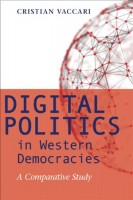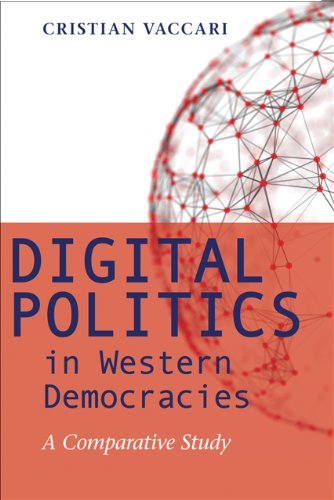 Author: Cristian Vaccari
Author: Cristian Vaccari
Publisher: Johns Hopkins University Press
Book Review by: Paiso Jamakar
How do the actors (e.g. candidates for elective office) in a political system communicate with their constituents (e.g. voters)? This book studies how such interaction occurs in today’s rapid pace of interpersonal and mass communication.
This book can be very useful to students, practitioners, and scholars of political communication, party competition and organization, and the current media landscape
The book is essentially a discussion of the production-presentation, on the one hand, and consumption on the other hand, of online content in seven countries – Australia, France, Germany, Italy, Spain, the United Kingdom and the United States. These seven countries represent 46 percent of the online population of democracies worldwide. It is an analysis of four years of data from 2006 to 2010 that consists of interactions between political actors and their constituents.
The author, a political science professor, points out that the websites located in the United States do not create homogenized American-style politics and political interaction, as some have claimed. Each nation’s unique constraints and opportunities create different responses, his studies reveal.
The coverage of topics in this book is organized in the following way in the Contents page:
- Introduction
- Theoretical Issues and Research Questions
- Understanding Digital Politics in Western Democracies
- Parties and the Internet
- Citizens and the Internet
- Parties and Digital Politics
- Structure and Features of Political Websites
- Disparities in Political Websites
- Party Characteristics and Their Online Presence
- What Drives the Online Presence of Parties and Candidates?
- Citizens and Digital Politics
- Online Political Information in Seven Countries
- Socioeconomic Inequalities and Online Political Information
- Political Attitudes and Online Information
- Political Engagement, Mass Media Use, and Online Information
- Correlates of Online Political Information in Seven Democracies
- Conclusion
This book looks at theoretical challenges and research methodology; how parties and candidates structure their websites; how citizens use the websites to access information; and how the research results tie back to inequalities, engagement, and competition in today’s digital politics.
How has the rise of digital politics helped different sectors of society in their work? The author points out four groups of people – who participate or contribute to political interaction – that have benefited from digital politics:
- Politicians are provided with role models and success stories
- Professionals (e.g. PR agents) have learned from best practices and gained clients
- Journalists have been able to make ready-made comparisons and metaphors
- Scholars have formulated theories and new approaches to problems
The results of this study presented in various charts and graphs are very interesting and enlightening. For example, on page 133 is a chart entitled Online Political Information in Seven Countries. It shows that in the 2008 general elections, 45 percent of the United States’ population and 60 percent of Internet users got political information online, whereas in Spain only 10 percent of its population and about 18 percent of Internet users did the same in that year.
This is an interesting, unusual book that breaks new ground, and is indeed a very enlightening, informative one.
Cristian Vaccari is an assistant professor of political science at the University of Bologna and a lecturer at Royal Holloway University of London







